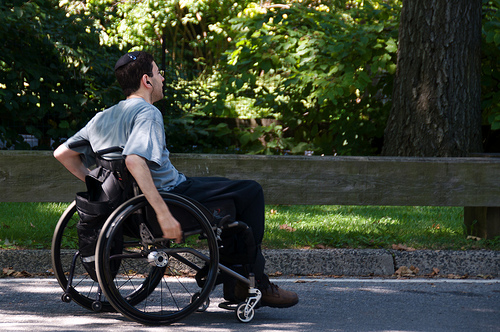Disabled Residents Scenario Outcome

photo by Flickr user Ed Yourdon
Ensuring that all residents have access to the region's economic, educational, housing, and other assets is a priority of the GO TO 2040 plan. To create a region that provides a high quality of life for all people, regardless of disability, we must consider aspects of planning and policy that affect how people interact with the built environment.
The purpose of the questions below is to understand how today's planning policy and investment decisions – covering transportation, land use, housing, economic development, and the natural environment – might affect the lives of disabled residents in our region in 2040.
How would disabled residents be affected by different transportation investment alternatives: focusing on major infrastructure investments (road or rail expansions); low-capital operational improvements (improved bus service, sidewalks, and trails); or technology (including real-time information or improved traffic signal timings)?
-
Transportation affects the ability of disabled residents to hold a job and earn an income, receive medical treatment, and overall function within society at large, making it a key consideration in quality of life. Improvements in paratransit service (defined to include all demand-responsive service, not just service required by ADA) are more consistent with a low-capital, operational approach to transportation, rather than an approach focusing on major infrastructure investment.
- The accessibility of transit services is necessary for them to be usable by disabled people, so multimodal transportation approaches that focus on accessibility are important. If they are accessible, fixed-route transit services can be used by many disabled people, although some disabled residents require paratransit service even if fixed-route exists nearby.
How would disabled residents be affected by different land use policies: focusing on dense, infill development; moderate densities with emphasis on community-centered design; or low-density new development?
- Denser developments are generally friendlier to disabled residents than low-density developments. There is greater opportunity to access services, stores, medical offices, entertainment, or other destinations in denser developments for disabled residents with mobility restrictions.
- Denser development also makes it more feasible to operate efficient fixed-route transit and paratransit service.
How would disabled residents be affected by housing policies: preserving existing affordable housing; creating new affordable housing near transit and jobs; or reducing housing costs through energy efficiency improvements?
- National policy currently favors providing services to disabled family members in the home, rather than traveling to service providers or institutionalization. This can reduce the travel needs of some disabled residents, but can also lead to social isolation.
- There are limited housing options for individuals with disabilities throughout the region. Combined with economic barriers, access to affordable housing for individuals with disabilities is a significant challenge. The creation of new affordable housing including rental units is important for these individuals.
- Among people with physical disabilities, housing needs can be addressed by incorporating universal design principles; among those with developmental disabilities, more supportive housing options are needed. There is a great deal of demand for new housing, particularly with regard to group homes and assisted living centers.